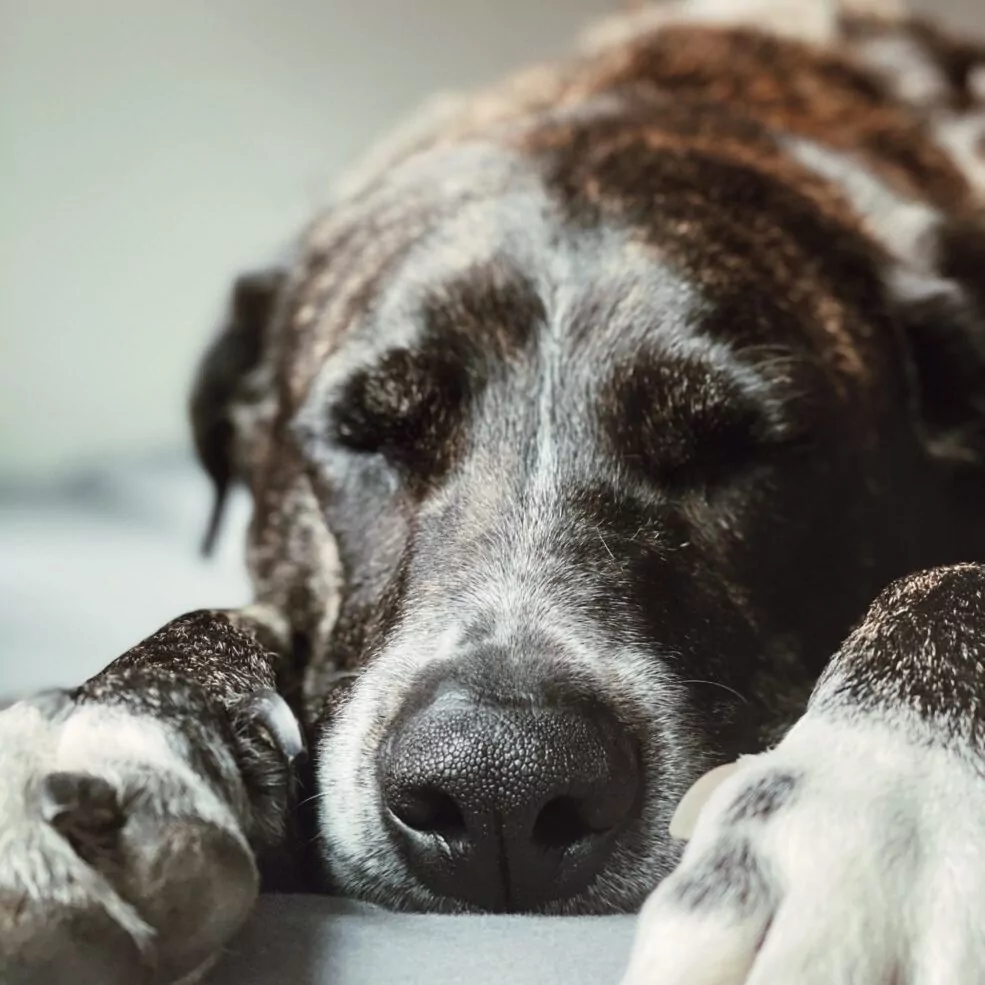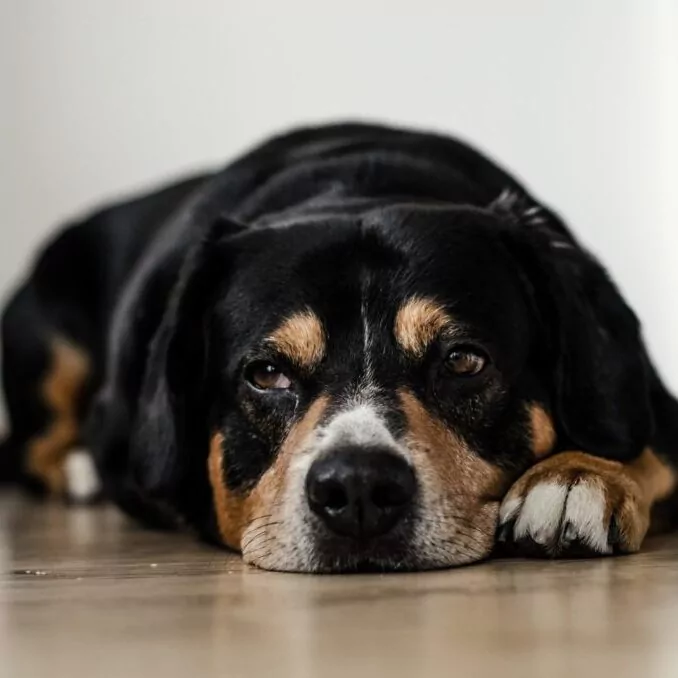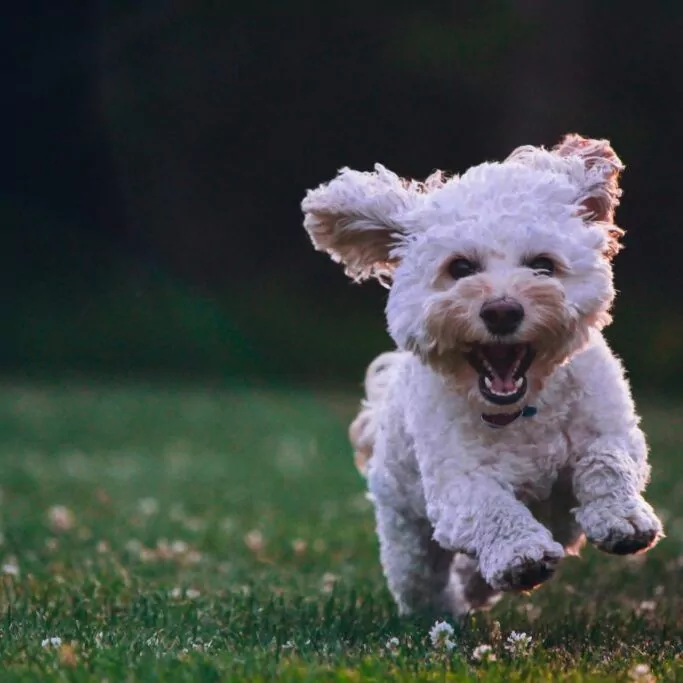Behavior & Symptoms
Why Is My Dog Panting?

There’s doggy breath and then there’s doggy breathing. You know to alert your veterinarian if your dog’s breath starts to smell foul, but how much attention do you pay to how your dog breathes?
Noting and reporting any changes in how your dog breathes and yes, pants, promptly to your veterinarian may help detect a serious medical condition that can be treated early and extend your dog’s healthy life. Stress and fear can also cause panting to accelerate.
It’s time to get schooled in Dog Panting 101. Ready? Let’s begin.
For starters, dogs pant in three ways:
- Inhaling and exhaling through the nose
- Inhaling through the nose and exhaling through the mouth
- Inhaling and exhaling through both the nose and mouth
Why? A major reason is to keep the canine body at a comfy temperature. Healthy temperatures in dogs are a tad higher than in people. Your dog’s temperature should range between 99.5 and 102.5 degrees Fahrenheit. A couple of degrees below or above that range could impact a dog’s health.
“Dogs don’t sweat like people do and thus, depend on panting to cool down,” says Julio Lopez, DVM, DACVIM, a board-certified internal medicine specialist at Encino Veterinary Center in Encino, California, and VetScoop contributor. “Panting allows cooling via evaporation of moisture from the surface of their mouths and tongues. When moisture evaporates from those surfaces, it also carries heat with it, leaving behind a cool surface.”
Unlike us, dogs lack pores (small openings that release sweat and oils) on their skin. In simple terms, we sweat. Dogs pant. In both species, the goal is to regulate the body’s temperature so that it stays within a healthy range and keeps organs and body systems, including circulation and respiration, operating effectively.
No matter the breed or size or age, all canines pant. The pace of the inhales and exhales depends on your dog’s size and health condition. Smaller dogs, including Chihuahuas and Shih Tzus, have faster respiratory rates than big breeds, such as Great Danes and Bernese Mountain Dogs.
Some panting is perfectly normal. You expect your dog’s tongue to be flopping out of his mouth after a brisk 30-minute walk or a vigorous game of fetch in the backyard. You find yourself breathing faster and harder after an intense gym workout.
“Play is vigorous, so dogs are going to pant during that type of physical exercise,” says Lisa Radosta, DVM, DACVB, a board-certified veterinary behaviorist who operates the Florida Veterinary Behavior Service in West Palm Beach, Florida. She is also a VetScoop contributor and serves on the Fear Free executive committee. “Even if he is enjoying the play, we want to interrupt play when dogs are panting heavily so that they don’t overheat.”
Too Much Activity Can Cause Heatstroke
Excessive panting can signal that a dog is dangerously approaching heatstroke. In dogs, sweat can’t escape through pores, but it is released through their paw pads when they start to become overheated. That’s not a very efficient cooling mechanism, however. If it’s unsuccessful, a dog’s core body temperature can spike and cause heatstroke, leading to seizures and even death.
Here are some key heatstroke warning signs:
- Red gums (healthy gums should be bubblegum pink in color.)
- Excessive panting with the tongue wide
- Vomiting, diarrhea or both
- Clumsy and uncoordinated movement when walking
- Muscle tremors
- Rapid heart rate
- Collapsing into unconsciousness
How Panting Is Affected by Breed
Some dogs are at greater risk for heatstroke simply due to their head structure or thick coat. Brachycephalic breeds (dogs with flat, pushed-in faces) are twice as likely to suffer heatstroke because they have short muzzles and nasal passages, plus narrow tracheas, making it more difficult for them to regulate their body temperature.
These breeds include the following:
- Boston Terrier
- Bulldog
- Boxer
- Cavalier King Charles Spaniel
- French Bulldog
- Mastiff
- Pekingese
- Pug
- Shih Tzu
Dogs with thick, heavy coats can also suffer heatstroke in hot weather because their coats trap hot air and elevate the body’s core temperature to dangerous levels. These breeds include the Akita, American Eskimo Dog, Alaskan Malamute, Bernese Mountain Dog, Chow Chow, Golden Retriever, and Siberian Husky.
How can you help your dog enjoy play time safely? In hot weather, schedule walks during cool mornings and pay attention to the pace of your dog’s panting. Stop the exercise, usher your dog into the shade or your air-conditioned home, and offer cool water for your dog to drink to help cool his body.
Medical Conditions Can Cause Panting
Heatstroke isn’t the only medical condition that causes a dog to pant heavily. There’s a long list of chronic conditions paired with excessive panting:
- Addison’s Disease (hypoadrenocorticism) – A dog’s adrenal glands fail to make enough of two key steroids: cortisol and aldosterone. They regulate metabolism and blood pressure and much more.
- Cushing’s Disease (hyperadrenocorticism) – A dog’s adrenal glands make too much cortisol and can lead to kidney disease and diabetes.
- Heart issues – A dog’s heart may not pump oxygenated blood efficiently, due to being old or dealing with heartworm disease.
- Obesity – A dog carrying excess weight has a heavy strain on the heart and lungs, causing breathing difficulties.
- Allergic reactions to medicines or toxins can affect a dog’s ability to breath and cause anaphylactic shock.
- Lung issues – A dog with a lung condition tends to get out of breath easily and pant excessively.
“There are many diseases that can cause panting, including pain and discomfort and finding the cause may not be easy,” says Dr. Lopez. “Your veterinarian will perform a thorough exam and based on the findings, further testing, including a blood and urine test or radiographs, may be recommended to try and find a cause and a treatment.”
Emotions Can Cause Panting
Some dogs pant excessively because they feel scared, anxious, or tense – emotions that can raise body temperature and trigger panting episodes. This type is like the human equivalent of sweaty palms in worried people.
“You should be able to see if your dog is stressed by reading his body language,” says Dr. Radosta. “Dogs with storm phobia may try to hide, escape, tremble, climb on top of or behind the pet parent, pant, pace, and refuse to eat. Treatment for stress-based panting depends on the dog and the clinical signs that the dog exhibits.”
The sound of fireworks, thunderstorms, loud construction noise, or even a noisy vacuum cleaner may cause some dogs to pace and pant uncontrollably.
Dr. Radosta says it is vital to work closely with your veterinarian to ensure that your dog receives the right medication in the right dose and duration to help him return to a calm state.
“Some dogs need just one medication and some dogs need two medications,” she says. “One may be long term, such as an antidepressant, and one may be short term, such as benzodiazepines, gabapentin, or Sileo.”
Also talk to your veterinarian about a behavior-modification program that may include providing your dog with a safe place inside your home during the noisy time and use of plug-in calming pheromone products such as Adaptil. Music therapy and body-wrapping clothing may help a frightened dog to stop panting and breathe normally again.
Take-home message: Dogs pant for a variety of reasons. Some panting is perfectly normal and safe. Other times, it’s a warning sign that your dog is dealing with a serious emotional or medical issue that should be reported promptly to your veterinarian.
“Dogs may pant when they are excited and playing, but they can also pant due to being in warm weather or due to stress or anxiety,” says Dr. Lopez. “If the panting continues without apparent reason or if there are other signs, such as weakness, coughing or collapse, all warrant a call to your veterinarian.”
Did you find this helpful? Share it!
Questions for your Vet
- Why does my dog pant at night?
- Why does my dog’s tongue stick out when she pants?
- Why does my Pug pant more than my Poodle?
About VetScoop
Pets make our lives better. At VetScoop, we’re on a mission to return the favor by giving you access to trustworthy, science-based information so you can provide the best possible care for your pets.
Related Articles We Think You'd Like





